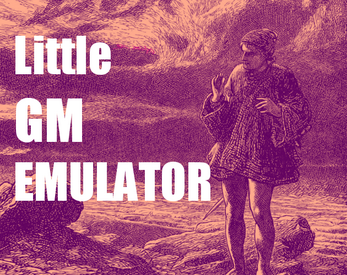Little GM Emulator
A downloadable game
Buy Now$4.99 USD or more
The Little GM Emulator provides a framework that enables solo gameplay of traditional RPGs originally meant for group play. It features a range of mechanisms to answer questions, generate random elements such as events, NPCs, and locations, manage the game flow, and even guide NPC interactions.
Contents:
- Introduction
- The Basics
- Core Concepts
- Theme and System
- The Emulator’s Role
- The Importance of Interpretation
- Game Structure
- Time Limit
- In-Game Day
- Playing Solo
- The Quest
- Game Flow
- Scene Event
- Answering Questions
- Yes/No Questions
- How it Works
- Probability
- Likely (1d6)
- Unlikely (2d6)
- Impossible (3d6)
- Understanding the Answers
- Examples
- Open Questions
- Action
- Theme
- Examples
- Yes/No Questions
- Oracles
- Random Event
- Revelation
- Challenge
- Challenge Type
- Difficulty Level
- Negative Consequences
- Danger
- NPC
- Gender Appearance
- Age
- Personality Trait
- Height
- Build
- Clothing
- Attitude
- Mood
- Motivation
- Interaction
- Location
- Purpose or Function
- Structural Element
- Environmental Feature
- Notable Features
- Atmosphere
- Hazards or Challenges
- Quick Dungeon Generator
- Dungeon Status
- Dungeon Segment
- Segment Size
- Corridor Contents
- Room Contents
- Exits
- Exit Status
- Random Event
- Random Tables
- Additional Detail
- Distance
- Size
- Weather
- Adjective
- Cosmic Horror
- Fantasy
- Generic
- Items
- Cosmic Horror
- Fantasy
- Modern
- Appendix
- Cooperative Play
- Safety Tools
- Setting the Stage
- Character Creation
- Time Limit
- Answering Questions
- Scenes
- Handling Events
- Playing Published Modules
- Cooperative Play
Review
| Status | Released |
| Category | Physical game |
| Rating | Rated 5.0 out of 5 stars (1 total ratings) |
| Author | Gustavo Coelho |
| Genre | Role Playing |
| Tags | accessory, gm-emulator, GM-Less, oracle, rpglatam, Solo RPG, Supplement, Tabletop, Tabletop role-playing game |
Purchase
Buy Now$4.99 USD or more
In order to download this game you must purchase it at or above the minimum price of $4.99 USD. You will get access to the following files:
little-gme.pdf 8.5 MB
little-gme-yes-no-questions-oracle-fanzine.pdf 319 kB
little-gme-open-questions-oracle-fanzine.pdf 148 kB
little-gme-npc-oracle-fanzine.pdf 161 kB
little-gme-location-oracle-fanzine.pdf 344 kB
Download demo
Download
little-gme-preview.pdf 2.2 MB
Development log
- Printable Zine OraclesSep 11, 2024

Comments
Log in with itch.io to leave a comment.
Is there anywhere to purchase a physical copy?
There is no physical version. However, the download includes printable minizines for the main oracles: Yes/No Questions, Open Questions, NPCs, and Locations.
Been trying to think of ways to reconcile the scene/day structure with dungeons and hex crawling. I may have missed something in the book, but what I came up with:
(on page 5) "Change for dungeon and hex crawling. Each turn is a scene, and there is no limit of 6 as in normal play, nor day structure. However, still track time as system. If there is an encounter, this overrides any scene event."
However, thinking about it, you could also place any hex crawling turn/day encounter on any appropriate scene as an override, for sake of keeping more to little-gme mechanics. As well, you could treat the dungeon excursion as an extended scene or even as all 6 scenes, with each scene having multiple rooms handled as standard system crawling procedures. A lot of this has arisen from trying to reconcile this supplement with OD&D/0e specifically.
Since Little GME is more narrative-oriented, you don’t need to strictly map every crawl turn to a Scene unless that level of granularity serves your story.
Here are a couple of ways you can adapt it:
The core idea is to let the passage of narrative time, not just mechanical time, shape your use of Scenes.
Hope this helps clarify things.
Yeah after posting my bit yesterday I did kinda realize like you said, "wait I can just treat crawling as seperate", but yeah I do like these as well. Just have to decide how I wanna do it ig. thankyou for the authorial feedback!